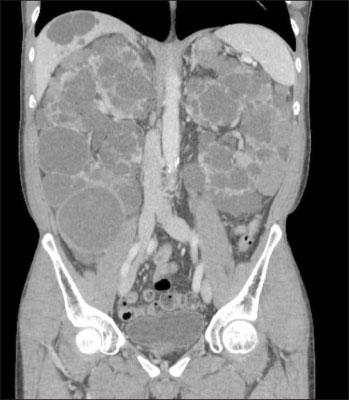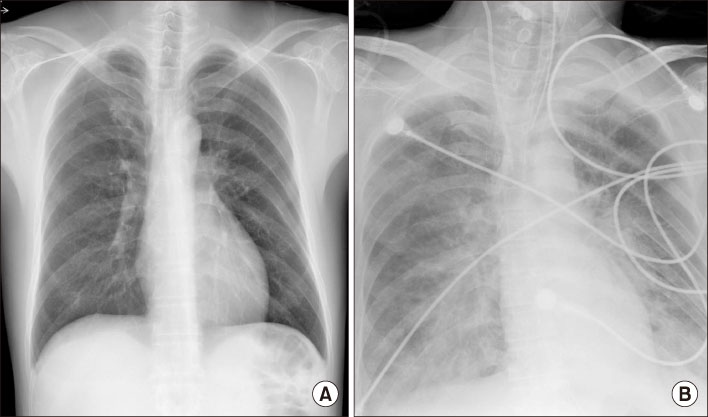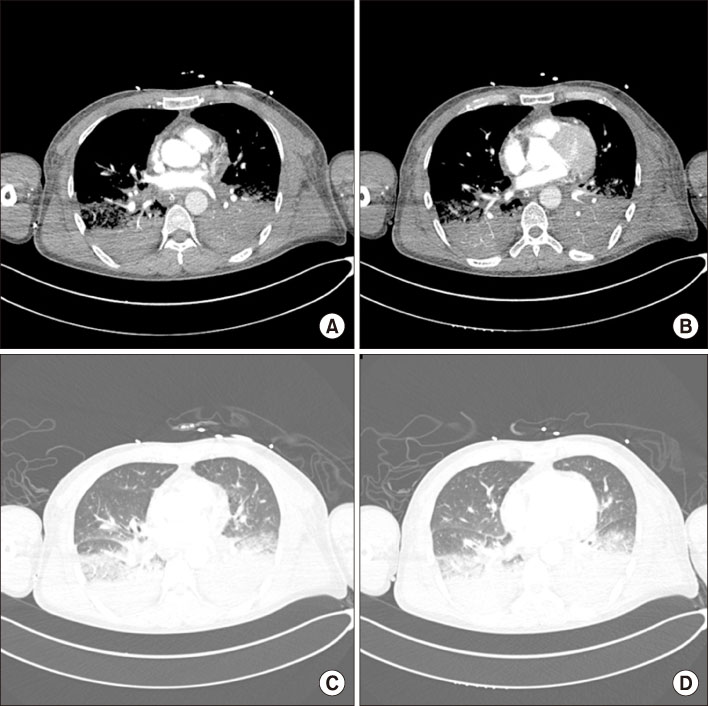J Korean Soc Transplant.
2018 Sep;32(3):63-68. 10.4285/jkstn.2018.32.3.63.
Basiliximab-Induced Non-Cardiogenic Pulmonary Edema in a Kidney Transplant Patient
- Affiliations
-
- 1Department of Internal Medicine, Inje University Haeundae Paik Hospital, Inje University College of Medicine, Busan, Korea. kyw8625@chol.com
- 2Department of Neurology, Inje University Haeundae Paik Hospital, Inje University College of Medicine, Busan, Korea.
- KMID: 2421282
- DOI: http://doi.org/10.4285/jkstn.2018.32.3.63
Abstract
- Induction therapy with basiliximab is widely administered after kidney transplantation to prevent acute rejection. Herein, we report a case of non-cardiogenic pulmonary edema induced by basiliximab. To the best of our knowledge, such case has not been reported to date in Korea. A 54-year-old man with polycystic kidney disease received kidney transplantation. As induction therapy, he was prescribed basiliximab. On day 4, the second dose of basiliximab was administered. The patient complained of acute hypoxia 23 hours later, which led to circulatory collapse. He was discharged 3 weeks later with stable renal function. Pulmonary edema was presumed to have been caused by increased pulmonary capillary permeability. A possible hypothesis for this event occurring after the second basiliximab injection is steroid-related effects. Non-cardiogenic pulmonary edema is a complication that might occur after basiliximab induction therapy. Physicians should be aware of this potentially life-threatening complication.
Keyword
MeSH Terms
Figure
Reference
-
1. Pirsch JD, Ploeg RJ, Gange S, D'Alessandro AM, Knechtle SJ, Sollinger HW, et al. Determinants of graft survival after renal transplantation. Transplantation. 1996; 61:1581–1586.
Article2. Meier-Kriesche HU, Schold JD, Srinivas TR, Kaplan B. Lack of improvement in renal allograft survival despite a marked decrease in acute rejection rates over the most recent era. Am J Transplant. 2004; 4:378–383.
Article3. Al Najjar A, Etienne I, Le Pogamp P, Bridoux F, Le Meur Y, Toupance O, et al. Long-term results of monoclonal anti-Il2-receptor antibody versus polyclonal antilymphocyte antibodies as induction therapy in renal transplantation. Transplant Proc. 2006; 38:2298–2299.
Article4. Nashan B, Moore R, Amlot P, Schmidt AG, Abeywickrama K, Soulillou JP. Randomised trial of basiliximab versus placebo for control of acute cellular rejection in renal allograft recipients. CHIB 201 International Study Group. Lancet. 1997; 350:1193–1198.
Article5. Goldman M, Abramowicz D, De Pauw L, Alegre ML, Widera I, Vereerstraeten P, et al. OKT3-induced cytokine release attenuation by high-dose methylprednisolone. Lancet. 1989; 2:802–803.
Article6. Gaston RS, Deierhoi MH, Patterson T, Prasthofer E, Julian BA, Barber WH, et al. OKT3 first-dose reaction: association with T cell subsets and cytokine release. Kidney Int. 1991; 39:141–148.
Article7. Leonard PA, Woodside KJ, Gugliuzza KK, Sur S, Daller JA. Safe administration of a humanized murine antibody after anaphylaxis to a chimeric murine antibody. Transplantation. 2002; 74:1697–1700.
Article8. Riegert-Johnson DL, Godfrey JA, Myers JL, Hubmayr RD, Sandborn WJ, Loftus EV Jr. Delayed hypersensitivity reaction and acute respiratory distress syndrome following infliximab infusion. Inflamm Bowel Dis. 2002; 8:186–191.
Article9. Barros VR, Rocha V, Garcia VD, Garcia CD. Anaphylactic shock after retreatment with basiliximab. Transplant Proc. 2003; 35:579.
Article10. Wouters KM, Lane MH, Walker I. Acute hypersensitivity reaction on re-exposure to basiliximab in an infant undergoing heart transplantation. Paediatr Anaesth. 2008; 18:806–807.
Article11. Steinberg KP, Hudson LD. Acute lung injury and acute respiratory distress syndrome. The clinical syndrome. Clin Chest Med. 2000; 21:401–417.12. Downey GP, Dong Q, Kruger J, Dedhar S, Cherapanov V. Regulation of neutrophil activation in acute lung injury. Chest. 1999; 116:1 Suppl. 46S–54S.
Article13. Brattsand R, Linden M. Cytokine modulation by glucocorticoids: mechanisms and actions in cellular studies. Aliment Pharmacol Ther. 1996; 10:Suppl 2. 81–90.
Article14. Mitsuta K, Shimoda T, Fukushima C, Obase Y, Ayabe H, Matsuse H, et al. Preoperative steroid therapy inhibits cytokine production in the lung parenchyma in asthmatic patients. Chest. 2001; 120:1175–1183.
Article
- Full Text Links
- Actions
-
Cited
- CITED
-
- Close
- Share
- Similar articles
-
- Sodium nitroprusside on acute cardiogenic pulmonary edema in dogs: case reports
- A Delayed, Unusual Non-Cardiogenic Pulmonary Edema after Intravascular Administration of Non-Ionic, Low Osmolar Radiocontrast Media for Coronary Angiography
- Hyponatremia with Non-Cardiogenic Pulmonary edema, Seizure and Rhabdomyolysis after Bowel Preparation
- Pulmonary Edema: Radiographic Differential Diagnosis
- Bidirectional Crosstalk between Kidney and Lung






